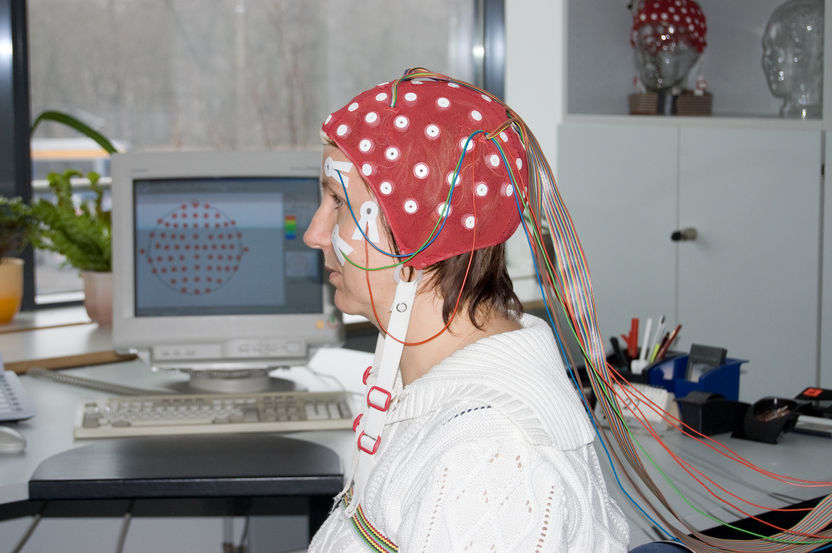Why there are bad learners
EEG activity predicts learning success
Advertisement
The reason why some people are worse at learning than others has been revealed by a research team from Berlin, Bochum, and Leipzig, operating within the framework of the Germany-wide network “Bernstein Focus State Dependencies of Learning”. They have discovered that the main problem is not that learning processes are inefficient per se, but that the brain insufficiently processes the information to be learned. The scientists trained the subjects’ sense of touch to be more sensitive. In subjects who responded well to the training, the EEG revealed characteristic changes in brain activity, more specifically in the alpha waves. These alpha waves show, among other things, how effectively the brain exploits the sensory information needed for learning. “An exciting question now is to what extent the alpha activity can be deliberately influenced with biofeedback”, says PD Dr. Hubert Dinse from the Neural Plasticity Lab of the Ruhr-Universität Bochum. “This could have enormous implications for therapy after brain injury or, quite generally, for the understanding of learning processes.”

EEG data recording
© MPI CBS Leipzig
Learning without attention: passive training of the sense of touch
How well we learn depends on genetic aspects, the individual brain anatomy, and, not least, on attention. “In recent years we have established a procedure with which we trigger learning processes in people that do not require attention”, says Hubert Dinse. The researchers were, therefore, able to exclude attention as a factor. They repeatedly stimulated the participants’ sense of touch for 30 minutes by electrically stimulating the skin of the hand. Before and after this passive training, they tested the so-called “two-point discrimination threshold”, a measure of the sensitivity of touch. For this, they applied gentle pressure to the hand with two needles and determined the smallest distance between the needles at which the patient still perceived them as separate stimuli. On average, the passive training improved the discrimination threshold by twelve percent—but not in all of the 26 participants. Using EEG, the team studied why some people learned better than others.
Imaging the brain state using EEG: the alpha waves are decisive
The cooperation partners from Berlin and Leipzig, PD Dr. Petra Ritter, Dr. Frank Freyer, and Dr. Robert Becker recorded the subjects’ spontaneous EEG before and during passive training. They then identified the components of the brain activity related to improvement in the discrimination test. The alpha activity was decisive, i.e., the brain activity was in the frequency range 8 to 12 hertz. The higher the alpha activity before the passive training, the better the people learned. In addition, the more the alpha activity decreased during passive training, the more easily they learned. These effects occurred in the somatosensory cortex, that is, where the sense of touch is located in the brain.
Researchers seek new methods for therapy
“How the alpha rhythm manages to affect learning is something we investigate with computer models”, says PD Dr. Petra Ritter, Head of the Working Group “Brain Modes” at the MPI Leipzig and the Berlin Charité. “Only when we understand the complex information processing in the brain, can we intervene specifically in the processes to help disorders”, adds Petra Ritter. New therapies are the aim of the cooperation network, which Ritter coordinates, the international “Virtual Brain” project, which her team collaborates on, and the “Neural Plasticity Lab”, chaired by Hubert Dinse at the RUB.
Learning is dependent on access to sensory information
A high level of alpha activity counts as a marker of the readiness of the brain to exploit new incoming information. Conversely, a strong decrease of alpha activity during sensory stimulation counts as an indicator that the brain processes stimuli particularly efficiently. The results, therefore, suggest that perception-based learning is highly dependent on how accessible the sensory information is. The alpha activity, as a marker of constantly changing brain states, modulates this accessibility.




























































